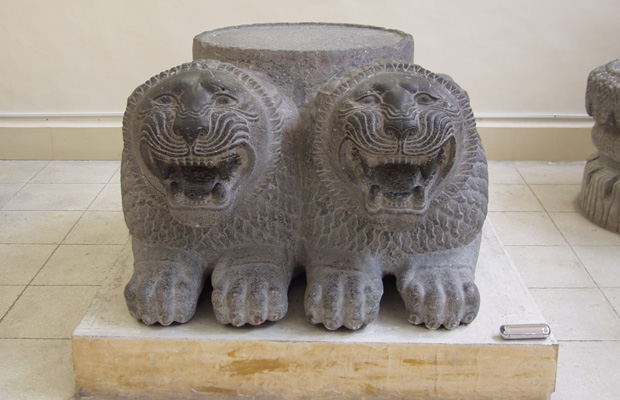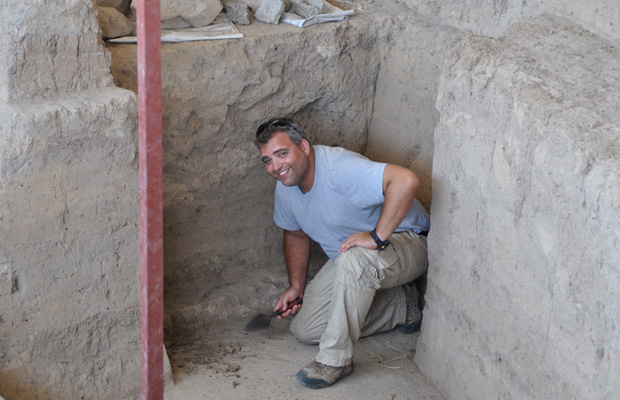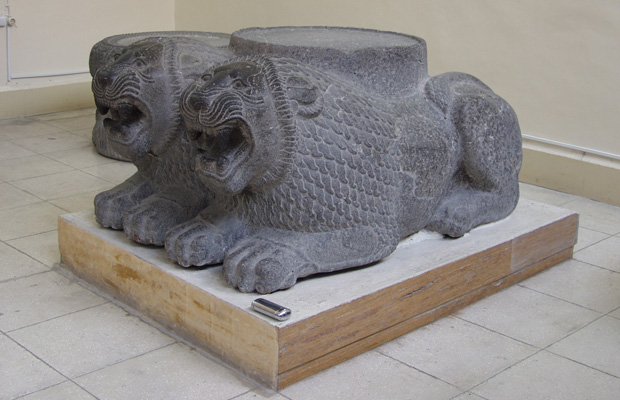
Then, he will try once more to shake out the secrets from astonishing ruins almost 3,000 years old.
The Ottawa archaeologist is working on one of the world's richest digs: 100,000 artefacts a year emerge from Tel Tayinat. But the shards, bits of gold, even the monumental palace and temple, only hint of the power and complexity that this ancient city once held.
Every day, the puzzle for Batiuk and his 30 or so colleagues in the University of Toronto team is the same: who were these people? How did they think? Who came through as traders, and who came waging war? Most intriguing: why did they simply walk away one day and vanish into history?
"Here we have this kingdom that sort of emerges out of nowhere," says Batiuk, 36. "So we are looking at how people come in from the Greek world, indigenous people, people from central Anatolia, further east ... how it all sort of coalesces into this new kingdom.
"We are looking at early multiculturalism, to borrow a Canadian term, how art and written language got going. The temple can give us an idea of how religion played a role in forming national identity."

One of the most important tasks this summer is to restore the fragile tablet and continue with translation.
Tim Harrison, the University of Toronto professor who directs the dig, and who supervised Batiuk's doctoral thesis, is even more effusive about the yield here. "Square metre per metre, (this) probably has the richest or densest amount of cultural or archaeological material anywhere in the world.
"The pace of discovery has been faster than what I prepared for, and the nature of the discovery has exceeded our dreams. It's an amazing place.
"Tayinat was the precursor to Antioch, which was second only to Rome as the greatest city of the classical world in the Mediterranean," says Harrison.
"I keep using the term crossroads or intersection. It's like an epicentre. So many different things have happened here."
Last year, a pre-eminent scholar suggested this may have been the seat of a powerful and extensive kingdom, ruled by a King Taita somewhere around the 10th century BC. This is unlikely to be related to today's Palestine, but it might be tied to the Biblical Philistines.
If this proves to be correct, it will shed light on what is now called the Dark Ages that began about 1200 BC when all the most advanced empires inexplicably crumbled.
Tel Tayinat is at the northern most tip of what was once the Levant, what most people think of as the ancient Holy Land, extending up from Jerusalem along the Mediterranean coast. It is at one corner of the Amuq, a plain shaped like a triangle, each side about 35 kilometres, bound by the Mediterranean on the west, and the Syrian border on the east and south.
Mankind has lived on this fertile plain for millennia, but most of the archaeological remains date from the early Bronze Age (3000 BC), up to the Iron Age (1200 to 550 BC.)
In the 1930s, the legendary archaeologist Robert Braidwood and his equally remarkable wife, Linda, worked with the British archaeologist Sir Leonard Woolley to find 178 archaeological sites in the plain. Braidwood, a luminary of the University of Chicago's Oriental Institute and a model for Steven Spielberg's Indiana Jones, began excavations at Tel Tayinat. Woolley took on Tel Atchana, just a few hundred metres away, often welcoming Agatha Christie and her archaeologist husband as guests at his humble "dig house" that still stands today.
Braidwood found pottery and other artefacts that provide one of the longest and most reliable chronological sequences in the entire Near East. Archaeologists still use it to date other sites in the Levant.
But the digs were abandoned as political tensions mounted in the years preceding the Second World War. Afterwards, the University of Chicago no longer focused on the area as its signature project and the Turkish government was hesitant to allow outside interests to excavate their patrimony. As late as the 1990s, Doug Esse, Harrison's mentor at the University of Toronto, tried for four years to get a permit to dig. By the time he finally got it, it was too late -- he was dying of cancer.
"I'll never forget seeing him in his home in March or April of 1992," said Harrison. "He showed me the permit. But we both knew he would never go. He died later that fall."
Finally, in 1995 a Turkish archaeologist teaching at the University of Chicago was permitted to dig. Aslihan Yener took on Atchana and asked Harrison to develop the Tayinat site.
Batiuk came on board as a graduate student working with Harrison, an assignment he had dreamed of since he was a teen.
Batiuk was anything but PhD material, judging by his first experience of high school in Orleans. He hated doing homework, and fell in with a crowd with a penchant for trouble.
After his third visit to the principal's office, his parents switched him to Colonel By high school, where he had Pam Cowan as his classics teacher.
"The kids just sucked it up like sponges. What's not to like about a pyramid and a mummy?" Cowan is now retired, but she still loves ancient history, and still travels throughout the Middle East.
Todd Moore, a high school friend, says Batiuk always knew what he wanted to do with his life. Even the wallpaper in his bedroom had a pattern reminiscent of ancient Greek pottery.
Batiuk and his friends liked the movie Indiana Jones and Moore remembers playing the video game in Batiuk's basement.
"But don't call him Indy. He hates that. He says the only accurate thing they ever said in the movie is that 95 per cent of archaeology is done in the library."
Batiuk then went to the University of Ottawa, where he studied with Edmund Bloedow, a professor who had spent most of his life entranced by Turkish archaeology.
Today, Bloedow lives deep in the forest on the Carp escarpment, in an old log house scattered about with Turkish copper, pot shards, and obsidian tools.
Like all archaeologists, he can't quite say why it's so seductive, but, as he spreads out a map of Turkey on the floor and points out the ancient Hittite capital northwest of Tayinat, it's clear that the fascination lingers still.
Batiuk says he's amazed at the ingenuity of ancient civilizations. "They did a lot of things we did, but they came at things at a different way, and that just really made me want to find out about them. Something as simple of plumbing -- you go to the middle Bronze Age and they have entire sewage systems, and they are bringing fresh water into the house. It's stuff we take for granted as modern, but no, it really isn't that modern."
He laughs off the adventurous side of his work, even though his friends and family speak with awe about his scrapes and near misses.
Says Moore: "When communism fell, guess where Steve was? With his dance group in the Ukraine.
"He was in Turkey for earthquakes, Mexico City for shootings, Paris for bombings."
His dad, Ted, notes that his son was in a pit once with scorpions, although Batiuk downplays that.
"I have had scorpions on a square (or dig area)," he admits. "I don't know that it was a pit. I think there might be a little hyperbole.
"But, yeah, we had to escape from Georgia (in Russia). That was a bit stressful. We had a bunch of undergraduate students from a college in the States and the parents were calling on a regular basis. I still think if we had waited a few more days, we would have been fine."
On Monday, Citizen reporter Jennifer Green will join Stephen Batiuk and Tim Harrison at their dig for 10 days. There, she'll look at how modern technology, developed in Canada, helps archaeologists decide where to dig. She'll follow a conservator who is painstakingly stabilizing that important tablet found last year. She will delve further into the known history of the area, and look into the enduring romance of archaeology.




Reader Comments
to our Newsletter